RemoveCSOs¶
Purpose¶
RemoveCSOs removes specific types from the input CSO list and passes a newly calculated one to the output which has been adjusted from the selected CSO types. Currently open, closed, self intersecting, and non planar CSOs can be removed.
Details¶
If any CSO belongs to more than one group, for example if it is open and non planar, then it will be removed from the output even if only one of those categories is selected for removal.
This module does not modify and CSOGroup information; even if all CSOs of one group are removed then group information remains unchanged.
Windows¶
Default Panel¶

Input Fields¶
inCSOList0¶
- name: inCSOList0, type: MLBase¶
Base field which holds the input CSOList object.
Output Fields¶
outCSOList¶
- name: outCSOList, type: MLBase¶
Base field providing the modified CSOList object.
Parameter Fields¶
Field Index¶
|
|
|
|
|
|
|
|
|
|
|
|
|
||
|
||
|
Visible Fields¶
Update¶
- name: update, type: Trigger¶
Initiates update of all output field values.
Clear¶
- name: clear, type: Trigger¶
Clears all output field values to a clean initial state.
On Input Change Behavior¶
- name: onInputChangeBehavior, type: Enum, default: Clear, deprecated name: shouldAutoUpdate,shouldUpdateAutomatically¶
Declares how the module should react if a value of an input field changes.
Status Code¶
- name: statusCode, type: Enum, persistent: no¶
Reflects module’s status (successful or failed computations) as one of some predefined enumeration values.
Status Message¶
- name: statusMessage, type: String, persistent: no¶
Gives additional, detailed information about status code as human-readable message.
Has Valid Output¶
- name: hasValidOutput, type: Bool, persistent: no¶
Indicates validity of output field values (success of computation).
[]¶
- name: updateDone, type: Trigger, persistent: no¶
Notifies that an update was performed (Check status interface fields to identify success or failure).
In Should Remove Non Planar CSOs¶
- name: inShouldRemoveNonPlanarCSOs, type: Bool, default: FALSE¶
If enabled then non planar CSOs are removed, otherwise not.
Count: (outNonPlanarCSOsCount)¶
- name: outNonPlanarCSOsCount, type: Integer, persistent: no¶
Shows the number of non planar CSOs which have been removed.
IDs (outNonPlanarCSOsIDs)¶
- name: outNonPlanarCSOsIDs, type: String, persistent: no¶
The list of ids of removed non planar CSOs; empty if none has been removed.
In Should Remove Closed CSOs¶
- name: inShouldRemoveClosedCSOs, type: Bool, default: FALSE¶
If enabled then closed CSOs are removed, otherwise not.
Count: (outClosedCSOsCount)¶
- name: outClosedCSOsCount, type: Integer, persistent: no¶
The number of removed closed CSOs; empty if none has been removed.
IDs (outClosedCSOsIDs)¶
- name: outClosedCSOsIDs, type: String, persistent: no¶
The list of ids of removed closed CSOs; empty if none have been removed.
In Should Remove Open CSOs¶
- name: inShouldRemoveOpenCSOs, type: Bool, default: FALSE¶
If enabled then open CSOs are removed, otherwise not.
Count: (outOpenCSOsCount)¶
- name: outOpenCSOsCount, type: Integer, persistent: no¶
The number of removed open CSOs; empty if none has been removed.
IDs (outOpenCSOsIDs)¶
- name: outOpenCSOsIDs, type: String, persistent: no¶
The list of ids of removed open CSOs; empty if none have been removed.
In Should Remove Self Intersecting CSOs¶
- name: inShouldRemoveSelfIntersectingCSOs, type: Bool, default: FALSE¶
If enabled then self intersecting CSOs are removed, otherwise not.
Count: (outSelfIntersectingCSOsCount)¶
- name: outSelfIntersectingCSOsCount, type: Integer, persistent: no¶
The number of removed self intersecting CSOs; empty if none have been removed.
IDs (outSelfIntersectingCSOsIDs)¶
- name: outSelfIntersectingCSOsIDs, type: String, persistent: no¶
The list of ids of removed self intersecting CSOs; empty if none has been removed.